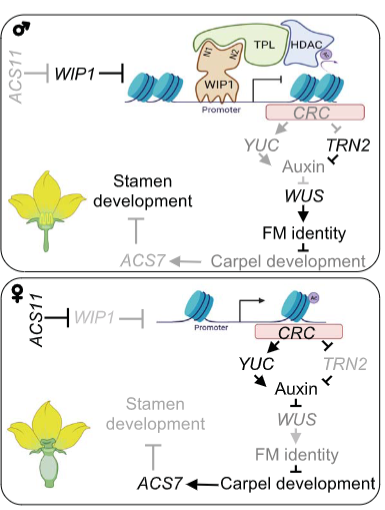A novel mechanism controlling sex determination
The control of the carpel determinism pathway leads to sex determination in cucurbits
To increase genetic diversity and fitness of offspring, flowering plants have developed several systems to prevent self-fertilization. As a result of sex determination processes, unisexual male and female flowers may develop on the same plant (monoecy) or on separate individuals (dioecy). The control of flower sex is useful for plant breeding for F1 hybrid seeds and for fruit production.
In a study published in Science, the group FLOCAD at IPS2 isolated a female-to-male sex transition mutant in melon and identified the causal gene as the carpel identity gene CRABS CLAW (CRC). The master regulator of sex determination in cucurbits, the transcription factor WIP1, whose expression orchestrates male flower development, recruits the corepressor TOPLESS to the CRC promoter to suppress its expression through histone deacetylation. Impairing TOPLESS-WIP1 physical interaction leads to CRC expression, carpel determination, and consequently, the expression of the stamina inhibitor, the aminocyclopropane-1-carboxylic acid synthase 7 (CmACS7), leading to female flower development. These findings suggest that sex genes evolved to interfere with flower meristematic function, leading to unisexual flower development.
The results described in this study are the result of a long collaboration involving the Institute of Plant Sciences Paris-Saclay (IPS2) and the Genetics and Improvement of Fruits and Vegetables Unit of INRAE in Avignon.

24/11/2022
